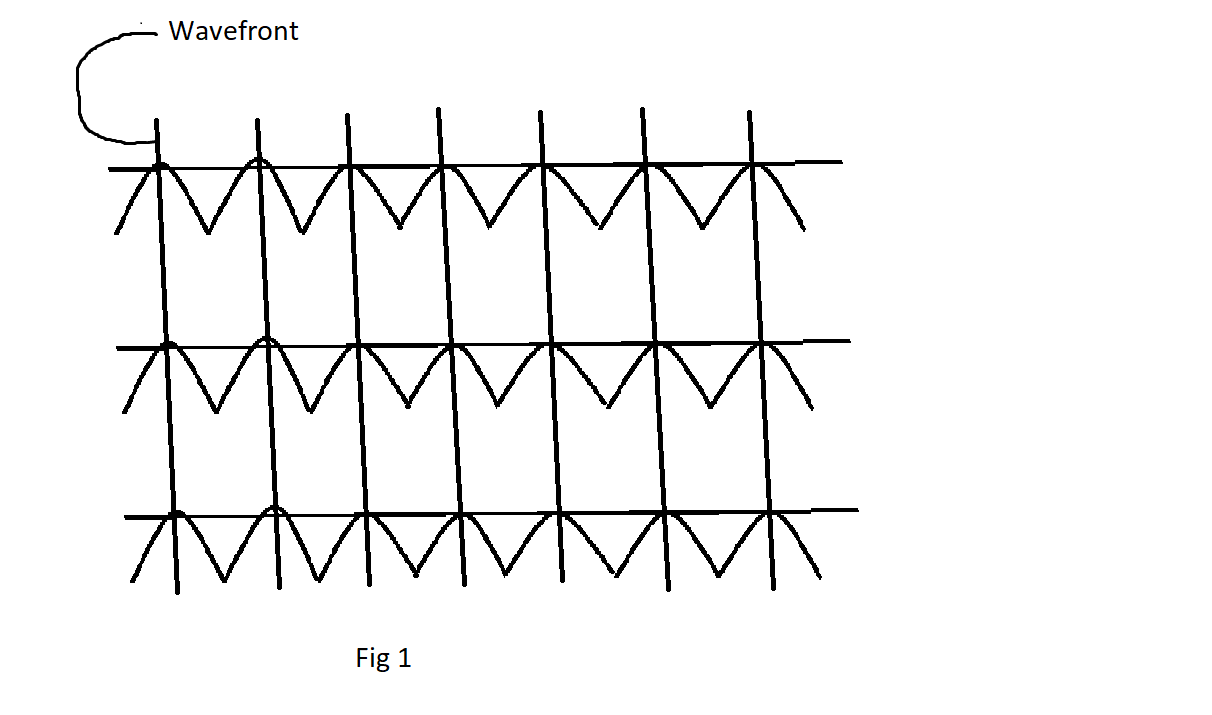
How is a Wavefront different from a Ray?
Answer
483.9k+ views
Hint: Wavefront is defined as the locus of all the points with a constant phase. The ray on the other hand on the wavefront is normal to the wavefront. Ray represents the direction of propagation of the wave through which travels.
Complete answer:
Wavefront is the set of all locations in a medium where the wave is at the same phase. This could be where all the crests are, where all the troughs are, or any phase in between. Wavefronts are useful for showing how waves are useful for showing how waves move in two dimensions. The length between two lines on a wavefront is exactly one wavelength.

The above diagram represents the wavefront.
Suppose if we take only the wavefront we can use it to represent rays.

Here the water waves travel from left to right. The ray is something that shows the direction of the water waves. Rays are always normal to the wavefront.
Thus we can summarize that the wavefront is the surface of the constant phase and the ray indicates the direction of the propagation.
Note:
There are three different types of the wavefront.
Plane wavefront: Plane wavefront has a constant wave phase along a planar surface or the wavefront.
Spherical wavefront: A spherical wavefront is the front of a propagating wave that has the shape of the ball
Cylindrical wavefront: This wavefront appears when the source of waves is a line source.
Wavefront’s shape always depends on the source. A wavefront from a point source is spherical or circular while an extended large source has a plane or flat wavefront.
Complete answer:
Wavefront is the set of all locations in a medium where the wave is at the same phase. This could be where all the crests are, where all the troughs are, or any phase in between. Wavefronts are useful for showing how waves are useful for showing how waves move in two dimensions. The length between two lines on a wavefront is exactly one wavelength.

The above diagram represents the wavefront.
Suppose if we take only the wavefront we can use it to represent rays.

Here the water waves travel from left to right. The ray is something that shows the direction of the water waves. Rays are always normal to the wavefront.
Thus we can summarize that the wavefront is the surface of the constant phase and the ray indicates the direction of the propagation.
Note:
There are three different types of the wavefront.
Plane wavefront: Plane wavefront has a constant wave phase along a planar surface or the wavefront.
Spherical wavefront: A spherical wavefront is the front of a propagating wave that has the shape of the ball
Cylindrical wavefront: This wavefront appears when the source of waves is a line source.
Wavefront’s shape always depends on the source. A wavefront from a point source is spherical or circular while an extended large source has a plane or flat wavefront.
Recently Updated Pages
A man running at a speed 5 ms is viewed in the side class 12 physics CBSE

The number of solutions in x in 02pi for which sqrt class 12 maths CBSE

State and explain Hardy Weinbergs Principle class 12 biology CBSE

Write any two methods of preparation of phenol Give class 12 chemistry CBSE

Which of the following statements is wrong a Amnion class 12 biology CBSE

Differentiate between action potential and resting class 12 biology CBSE

Trending doubts
What are the major means of transport Explain each class 12 social science CBSE

Which are the Top 10 Largest Countries of the World?

Draw a labelled sketch of the human eye class 12 physics CBSE

How much time does it take to bleed after eating p class 12 biology CBSE

Explain sex determination in humans with line diag class 12 biology CBSE

When was the first election held in India a 194748 class 12 sst CBSE




